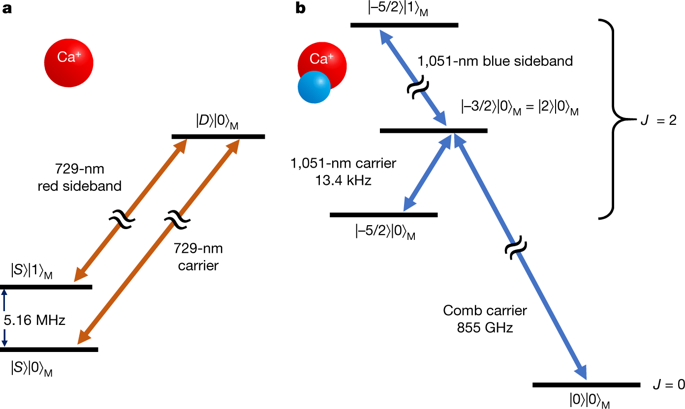USTC Realized Quantum Entanglement Involving Molecule
Recently, Prof. LIN Yiheng from CAS Key Laboratory of Microscale Magnetic Resonance of University of Science and Technology of China (USTC) of the Chinese Academy of Sciences (CAS) and international collaborators, have proved quantum entanglement involving a molecule feasible. This achievement, published in Nature on May 20th, may have broad applications in quantum information science and many other quantum-related subjects.
Molecule is a system of multiple atoms. Diverse relative motions within molecule, including various modes of rotation and vibration, can be quantized to quantum states with a broad energy span, from close to zero to hundreds of terahertz of optical frequency. Thus, it is possible for a single molecule, acting as a medium, to match and transduce information between hybrid quantum systems across a wide range of qubit frequencies.
In addition, long range interaction of molecules is also conducive to the realization of a new quantum information processing platform. Polar molecules are sensitivity to electric fields. This allows them to interact with microwave photonic systems, cantilever beam oscillators and other systems, which can be utilized to a better quantum control.
Demonstration of quantum entanglement involving an individually controlled molecule is necessary and critical, to realize such new quantum processing platform. Former experiments have had several breakthroughs in binding and cooling of molecules and so on. And in this research, researchers used laser to manipulate Ca+ atomic ions and GaH+ molecular ions trapped in an ion trap system.
This process is like taking CT photos of a man. To gain information of what’s inside his body, we must scan from different aspects, and it’s the same with to manipulate and measure molecules and atoms. Scientists should manipulate, and measure the different degrees of freedom in their experiments, such as orbital angular momentum, vibration and rotation. Lasers of varying intensity, direction, pulse train, and color, allowing atoms and molecules to switch between different states as expected, is an important tool.
Researchers first applied ground-state cooling and optical pumping on the Ca+ ion, ideally leaving the system in the s state of the orbital state. And then, they prepared the rotational state of GaH+ into the -3/2 state, at which time the coupled vibration quantum number was 0. If these two particles become entangled, the rotation state of the molecule would change corresponding to the change of atomic orbital state. That is to say, when the orbital state of the atom is s, the rotational state of the molecule should be -3/2, and when the atomic orbital is d, the rotational state of the molecule is supposed to be -5/2. Researchers used a pulsed laser called π/2 to excite a particle into a superposition of a lower energy state and a higher energy state to realize this. And in this case, the molecule is excited from a rotation state of -3/2 to a superposition of -3/2 and -5/2.
In the ion trap, Ca+ and GaH+ vibrate together because of their roughly same mass and coulomb force, as if they were connected by a spring. This coupled harmonic motion acts as a bridge between the rotational dynamics of the molecule and the orbital states of the atom, enables entangling manipulations. The corresponding atomic vibrational performance of -3/2 is 0, and the corresponding vibrational performance of -5/2 is 1, with both the orbital states to be s. The atoms with vibrational dynamics of 1 and orbital state of s could be transformed to vibrational dynamics of 0 and orbital state of d with laser selection. At this time, the entanglement of the atom and the molecule is realized.
Finally, the team measured the fidelity, which guarantees entanglement with a value greater than 0.5. Two cases, low-energy pairs of qubits, with the molecular rotation state to be -3/2 and -5/2, and high-energy pairs of qubits, the rotation states of which are 0 and 2, were measured, and the outcome were 87% and 76%, respectively. These values were both much greater than the threshold, validating the success of bipartite entanglement.

Schematic of atom and molecule included in this work, and energy levels and selected laser-driven transitions (Image by LIN Yiheng et al.)
Paper Link:
https://www.nature.com/articles/s41586-020-2257-1#Abs1
(Written by JIANG Pengcen, edited by LU Hongyu, USTC News Center)
Back
